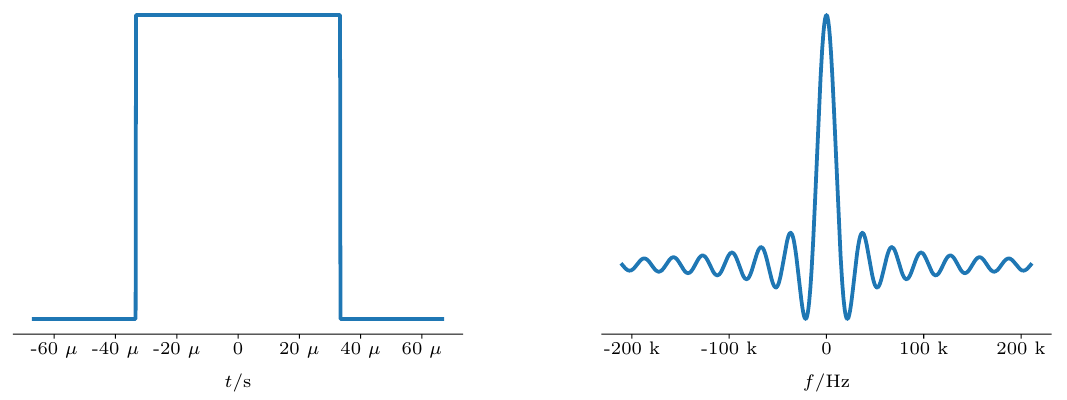Introduction
When I was writing my master thesis[1] I wanted the figures to look professional, meaning I wanted at least the same font in the figure as used all over my document. However, TikZ[2] was not an option, because I wanted to focus on the actual programming (and signal processing) tasks and not too much on my love for beautiful documents in the little time I was given. I searched the world wide web and I had a Morpheus moment when I came across the inkscape[3] --export-latex option.

Sounds pretty good, right? The suggested workflow with inkscape is a follows.
Create a SVG w/ Python
Let's get our hands dirty right away. As a first step an image needs to be created. Theoretically, it does not matter how the SVG is produced. I tried Python and draw.io.
The image decorating this post is a screenshot of a LaTeX compiled PDF. To give an example, I am going to show how to make those two plots leveraging Python in conjuction with matplotlib[4]. Here comes an excerpt of the code, which created those two waveforms.
from matplotlib import pyplot as plt
import numpy as np
from matplotlib.ticker import EngFormatter
# Settings
plt.rcParams['font.size'] = 12
plt.rcParams['svg.fonttype'] = 'none'
# Master thesis colors
color0 = '#00285e'
# Sexy formatter engineering style
formatter0 = EngFormatter(unit='')
formatter1 = EngFormatter(unit='s')
w = float(1)/15e3
carriers = 12
x = np.linspace(-15e3*(carriers+2),15e3*(carriers+2),1000)
# Single carrier
b = np.sinc(x*w)
plt.plot(x,b,label="\$\\frac{sin(f)}{f}\$", linewidth=3, color=color0)
# Plot formatting
axes = plt.gca()
axes.xaxis.set_major_formatter(formatter0)
axes.set_xlabel("\$f/\SI{}{\Hz}\$")
for side in ['right','top','left']:
axes.spines[side].set_visible(False)
axes.xaxis.labelpad = 15
axes.yaxis.labelpad = 15
plt.title("Single \gls{NB-IoT} Sub-Carrier")
plt.yticks([])
plt.savefig("ofdm_nbiot_sinc.svg", format="svg", transparent=True)
plt.clf()
# Pulse shape
t = np.linspace(-(1/15e3), 1/15e3, 1000)
boxcar = [0]*(len(t)/4) + [1]*(len(t)/2) + [0]*(len(t)/4)
plt.plot(t,boxcar,label="\$s(t)\$", linewidth=3, color=color0)
# Plot formatting
axes = plt.gca()
axes.set_xlabel("\$t/\SI{}{\second}\$")
axes.xaxis.set_major_formatter(formatter0)
for side in ['right','top','left']:
axes.spines[side].set_visible(False)
axes.xaxis.labelpad = 15
axes.yaxis.labelpad = 15
plt.title("\gls{NB-IoT} Pulse-Shape")
plt.yticks([])
plt.savefig("ofdm_nbiot_boxcar.svg", format="svg", transparent=True)
plt.clf()
Now there are two SVGs in that directory, which can be further processed.
Converting the SVG to LaTeX
The second step is pretty straight forward. Once you have a .svg file. You can feed it into inkscape and their great plugin will take care of (almost) all the rest.
inkscape -D --export-latex --export-filename=./figs/ofdm_nbiot_boxcar.pdf ./figs/ofdm_nbiot_boxcar.svg
As one can see, in that case all figures are stored in a directory called figs. This might concern you, since you found out, that the produced .pdf_tex file references to ofdm_nbiot_boxcar.pdf directly. I fixed this issue by calling rpl, a neat program to replace strings in files.
rpl -q ofdm_nbiot_boxcar.pdf ./figs/ofdm_nbiot_boxcar.pdf ./figs/ofdm_nbiot_boxcar.pdf_tex
Fixed it! Basically, you could also open the .pdf_tex output file in a standard editor and just find & replace every occurance (if you have nothing else to do).
Interfacing w/ LaTeX
All you need to do next is to include the following lines into your LaTeX document.
\begin{figure}[htbp]
\begin{subfigure}{0.49\columnwidth}
\centering
\scriptsize
\def\svgwidth{\columnwidth}
\input{./figs/ofdm_nbiot_boxcar.pdf_tex}
\caption{}
\label{fig:ofdm_nbiot_boxcar}
\end{subfigure}
\begin{subfigure}{0.49\columnwidth}
\centering
\scriptsize
\def\svgwidth{\columnwidth}
\input{./figs/ofdm_nbiot_sinc.pdf_tex}
\caption{}
\label{fig:ofdm_nbiot_sinc}
\end{subfigure}
\caption{Pulse shape of a \gls{NB-IoT} signal (a) and spectrum of one subcarrier (b).}
\label{fig:ofdm_shape_spectrum_1}
\end{figure}
In the example above each figure is scaled to the \columnwidth by calling \def\svgwidth{\columnwidth}. Moreover, the font size is set to \scriptsize (read all about it in [5]). These parameters can be modified to suit your personal needs. Above all there is a small document describing the inkscape plugin [6].
Adding convenience
Personally, I typically set up a small build system with Make [7] if I work on a larger LaTeX document for a longer time. However, there are many folks out there who appreciate the convenience, that overleaf.com poses, which I fully understand. Sometimes you also just work on some small LaTeX document and do not want to set up a complicated directory structure including a custom build system. I do this as well. For this reason, I wrote the prehaps ugliest webapp in the world. This webapp does all the aforementioned steps (after you have created a SVG) for you.
Here is the source code and you can access this app under v2l.stiefel.tech/converter.php.
How to use the app?
- Enter the name of the directory where you have stored your images e.g. figures.
- Upload the SVG file.
- Press Convert.
- Download the resulting files.
If you have any suggestions what to change about this app, please let me know in the comments below.


